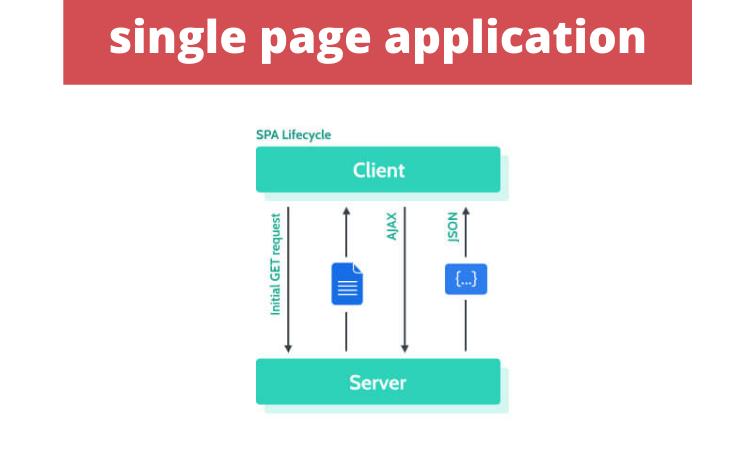Single Page Applications are websites that frequently rewrite the current page without reloading the entire new pages from the server which increases the loading speed. Single Page Applications (SPAs) are an excellent approach for developing unique and engaging user experiences.
Gmail, Google Maps, Airbnb, Netflix, Pinterest, Paypal, and a slew of other Single Page Applications leverage SPAs to deliver a smooth, scalable experience. Best web development companies in Chennai are creating SPAs while developing websites.
However, in the past, when it came to content management, SPAs have left marketers in the dark. Fortunately, you can now connect your SPA to the appropriate CMS, giving developers and marketers the power they need.
What’s Single Page Application?
A single page application (SPA) is a single page (thus the name) containing a large amount of data that remains constant and only a few parts that need to be altered all at once.
When you look through your email, for example, you’ll note that little changes throughout navigation – the sidebar and header remain unchanged as you navigate through your inbox.
With each click, the SPA just delivers the information you need, and your browser renders it. This differs from a typical page load, in which the server re-renders the entire page and delivers it to your browser with each click.
This piece-by-piece, client-side strategy drastically reduces the amount of data a server must transfer, making it far more cost-effective.
What’s Single Page Application Architecture? How Does it Work?
Instead of loading complete new pages from the server, a single page application interacts with the user by dynamically altering the existing page. This solution removes page transitions from the user’s experience, making the program feel more like a desktop application.
There is a lot of duplicate content on most websites.
Some of it is consistent throughout (headers, footers, logos, navigation bar, etc. ), while others are consistent within a given section (filter bars, banners), and other layouts and templates are repeated (blogs, self-service, the google mail setup mentioned above).
This recurrence is used by Single Page Applications.
Assume your website view is a painting of a home and a tree. Traditional multi-page websites render the complete image on the server before sending it to your browser.
SPAs provide you with the site’s paint-by-numbers directions, including any repeated guides you’ll likely use, and then feed the appropriate paint (data and content) into the template.
In each example, you see the same tree, but when you request extra material, such as clicking “next,” filtering results, opening a letter, or requesting to see a different tree in this small metaphor, the speed of SPA comes into play.
Your request for a new tree on a traditional website would trigger the server to re-paint the entire picture and send it back.
With a Single Page Application, the server says, “Hey, I’ve got a new tree for you, but you already have the house, so just leave that alone,” and then provides you updated instructions for a new tree as well as the paint you’ll need to construct it.
Instead of going through a whole reload, the page can be dynamically recreated by shifting the painting work (page rendering) from the server to the client (you).
This makes things a whole lot faster.
Advantages of Single-Page Applications
SPA solutions offer several benefits, including improved application performance and consistency, reduced development time, and lower infrastructure costs.
Development teams can work at different speeds while maintaining links to the entire solution by segregating the display from the content and data. Mobile, desktop, and tablet responsive designs are all created using SPA.
Loading a single file at a time
After the initial page load in each HTML, CSS, and JS Single Page Application, the server does not send any more HTML to you; you download it all at once.
When the server provides you a shell page, your browser renders the user interface (UI).
As you click about, the SPA sends back requests for data and markup, the server sends back the raw materials, and your browser interprets them and generates an updated UI – all without having to completely reload the page.
Because of their interchangeability, SPAs are especially useful on heavily trafficked pages with recurrent templates.
No additional server queries
Because they don’t have to spend as much time and energy on the whole drawing, SPAs have a lower overall effect on your servers, letting you save money by having fewer servers to handle the same amount of traffic.
Front-end Built for Speed and Responsiveness
SPAs allow developers to design the front-end faster, in addition to the performance advantages mentioned above. This is due to the separation of back-end services and front-end displays in SPAs. On the backend, many business-critical features don’t alter significantly.
While the “look” or presentation of how your consumers log in, register, purchase, and follow orders may change over time, the logic and data orchestration underlying it is rather consistent – and you don’t want to make a mistake with it. Similarly, your basic material and data may stay the same, but the way you present it may change.
You can transform that back-end logic and data into a “service” by divorcing it from how it’s presented, and developers can create a variety of front-end ways to exhibit and use that service. With a decoupled architecture, developers may create, deploy, and experiment with the front-end completely independent of the back-end technology.
They envision how the user experience should look and feel, and then leverage those services to bring in the content, data, and functionality. This is accomplished using APIs, which are a collection of rules that govern how programs organize, exchange, and reassemble data.
This API architecture allows developers to work quickly on the user interface while ensuring that business-critical back-end technologies are not jeopardized.
Improved User Experiences
As more and more features are developed as modular services (a microservice architecture) that can be adjusted separately, it’s getting easier to experiment with how they’re shown and used.
SPA frameworks are perfect for experimenting with these services to create engaging, dynamic, and even animated user experiences.
Furthermore, many people prefer to code in a specific programming language (many SPA frameworks use javascript), and thanks to APIs, SPAs built in one language can happily interact with back-end services written in another.

